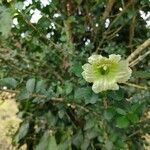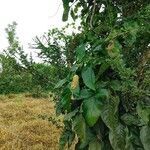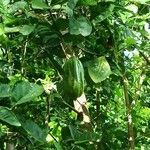A small evergreen tree. It grows 5-10 m high. It has a spreading crown. The trunk can be 8 cm across. The leaf stalks have narrow wings. The leaves are in rings on short spiny twigs. The leaves have 1-4 leaflets. They are 5 cm long. The flowers and fruit grow from the trunk or singly at the ends of branches. The flowers are large and irregular and bell shaped. They are up to 6 cm long. They usually occur . The tube shaped flowers are yellowish green with purple stripes. The fruit are pointed and yellowish green. The fruit are candle shaped and 12 cm long by 7 cm wide. The fruit is waxy. They are dull yellow and short and plump with ridges like okra. It has many angles and grooves.
Tree 7-8 m. Leaves articulated with very hard, thorny extension of the nodal bark, the latter remaining a permanent, ascending, sharp thorn; leaflets elliptic, narrowed at both ends, 2-5 by 1-3 cm; axillary fascicled leaves mostly simple. Flowers 1-several together, terminal, axillary or on branches or stem. Calyx spathaceous, 3-5 cm; corolla white, 6-7 cm. Berry pendent, cylindric, curved, costate with thick ribs, 8-17 cm by over 3 cm Ø.




